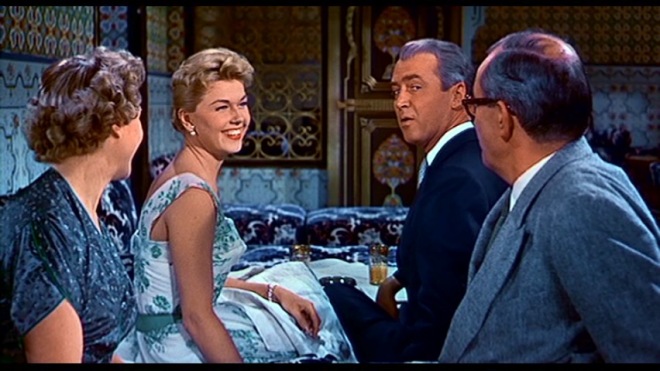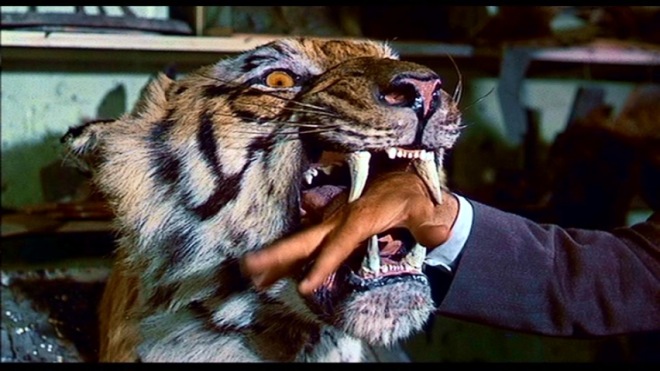THE M AN WHO KNEW TOO MUCH (1956) – Paramount – Rating: ★★★
AN WHO KNEW TOO MUCH (1956) – Paramount – Rating: ★★★
Color – 120 mins. – 1.85:1 aspect ratio
Principal cast: James Stewart (Dr. Ben McKenna), Doris Day (Jo McKenna), Christopher Olsen (Hank McKenna), Bernard Miles (Edward Drayton), Brenda De Banzie (Lucy Drayton), Daniel Gelin (Louis Bernard), Reggie Nalder (Rien).
Associate Producer: Herbert Coleman
Written by John Michael Hayes, from a story by Charles Bennett and D.B. Wyndham-Lewis
Cinematography by Robert Burks
Edited by George Tomasini
Original Music by Bernard Herrmann
Costume Designer: Edith Head
Art Direction by Hal Pereira and Henry Bumstead
Why would an A-list director like Alfred Hitchcock choose to remake one of his own films? He certainly wasn’t the only high-profile director in the “golden age” of film to do so: Frank Capra, Cecil B. DeMille, Howard Hawks and John Ford all directed remakes of earlier films in their catalogs. It may have been producer David O. Selznick who first planted the seed in Hitchcock’s mind. As early as 1941, Selznick told Hitchcock that he thought The Man Who Knew Too Much would be a good film to remake. Hitchcock (who was under contract to Selznick at the time), actually began writing a new treatment of the story with John Houseman, but nothing ever came of it.
Fast-forward about 13 years. Hitchcock was in the midst of his prolific run at Paramount Pictures in the mid 50’s. He had cranked out 3 films in less than two years, all penned by screenwriter John Michael Hayes. He owed Paramount one more movie, after which he had to fulfill a contractual obligation to Warner Brothers for a movie. Hitchcock already knew what movie he was going to make for Warner Brothers: The Wrong Man. But what movie would he first make for Paramount? A remake of The Man Who Knew Too Much, also written by Hayes.
The basic plot of this remake is the same as in the original film. The McKenna family, on vacation in an exotic locale, witness a murder, and the dying victim imparts vague knowledge of an upcoming assassination attempt. The child in this family is kidnapped, to prevent the parents from disclosing what they know to the police. So the parents set out to find their missing child on their own.
This film can be divided neatly into two parts: the first 49 or so minutes, which take place in Marrakesh, Morocco, and set up the murder and kidnapping; and the latter 71 minutes, which take place in London. The first section is by far the weaker of the two; the pace is at times drearily slow. Consider that Hitchcock’s original version of this movie took less than 15 minutes to shift the action to London, and this version takes over three times as long. There are two separate story threads at work in this first section of the movie. The overlying one introduces us to Ben and Jo McKenna (played by Jimmy Stewart and Doris Day), and their son Hank (Christopher Olsen), travelling in Marrakesh. The McKennas have several mysterious encounters, first with a man on a bus named Louis Bernard; later outside their hotel where a woman appears to be staring at Jo; and finally with a rather odd-looking man who “accidentally” knocks on their hotel room door. The attempt to slowly build up suspense has some nice touches, but overall it takes far too long to get going. Even attempts at humor don’t always work; much is made of Ben McKenna’s ignorance of (and annoyance with) eating customs in a traditional Moroccan restaurant. Yet he has earlier stated that he was in Morocco during the war. Certainly he would have observed some of the local customs? The underlying storyline is far more interesting, and this focuses on the state of the McKennas’ marriage.
John Michael Hayes often focused in his screenplays on the difficulties in relationships, how sacrifices must be made for any relationship to succeed. His screenplays often have men and women from different worlds, who have seemingly irreconcilable differences in career and hobbies. The best example of this is Rear Window, in which Jimmy Stewart’s character deflects all talk of marriage with the incredibly sublime Grace Kelly, because of their different jobs and social standing. The movie ending hints at a possible compromise. One could argue that the McKennas in The Man Who Knew Too Much are a logical progression of the couple from Rear Window. Ben McKenna is a successful doctor in Indianapolis, Jo is an accomplished singer on the Broadway stage who gave up her career for her husband. And thus is established a theme of patriarchal dominance (as pointed out by Steven DeRosa in his informative book “Writing with Hitchcock”) which is rather on point for mid-1950’s America, and might have made more than a few movie-going couples squirm in their seats a little.
There are a dozen examples of dialogue in the opening section of the movie that point to the frayed edges in the McKennas’ marriage, and most of them are written with the subtlety and humor that were Hayes’ trademark as a writer. Jo questions why Ben couldn’t be a doctor in New York, so she could appear on Broadway. She asks him when they will have another child, which clearly blindsides him. When their son Hank is getting ready for bed and sings the line “When I was just a little boy, I asked my mother what would I be?” the McKennas exchange a knowing glance. Clearly Ben wants his son to follow in his footsteps as a doctor, while Jo, by encouraging Hank’s singing, has other ideas.

The male dominance established in the film’s early sequence is not always so subtle. In the movies most disturbing scene, (and one of the most disturbing scenes in all of Hitchcock), Ben McKenna forces his wife to take a sedative before he tells her that their son has been kidnapped. By modern sensibilities this goes beyond patronizing. But I find it hard to believe that a 1950’s audience would have been any less disturbed. Doris Day’s performance in this scene is gut-wrenching and unforgettable. But as is usually the case with Hitchcock scripts, the male lead will be emasculated later on, and it is the female who will save the day.
As soon as the story transitions to London, the pace quickens, and this latter half of the movie is far better. The McKennas work (first separately, then together) to locate their kidnapped child, with the major set piece of the film being the assassination attempt at the Royal Albert Hall, just as in the original version. ( I will focus on a comparison between the Royal Albert Hall sequences in a later entry.) It is Doris Day who prevents the assassination, by screaming to throw off the shooter’s aim. And again it is Doris Day who uses her singing to attract the attention of her child in the movie’s final sequence.
Six minutes of self-indulgence: In one of the movies better sequences, Jimmy Stewart’s character goes in search of a man named Ambrose Chapell, not realizing that the name refers to a place, not a person. After a brilliant set-up and escalation of tension, the sequence moves into a taxidermy shop (which seems to specialize in exotic animals), where we quickly realize that Ben McKenna is not in the right place. Further, his rather bizarre and disturbing dialogue alarms the shopkeepers (it sounds as if McKenna is proposing that they stuff a dead person!) Clearly they think McKenna is a madman. There is much jostling around, before McKenna flees. This sequence ultimately serves no purpose in advancing the plot; it exists only for it’s own sake. The sole purpose is some comic relief, to deflate the building tension. Hitchcock enjoyed sequences like this. He once likened movies to riding a roller coaster, in that you have to give the audience ups and downs.

Performance: Jimmy Stewart is adequate in this film, but not nearly as strong as he was in both Rear Window and Vertigo. He does have several good moments. Doris Day, who is a polar opposite of the typical Hitchcock heroine, was astounding in this role. She gives an outstanding performance. Christopher Olsen has little to do in his role as Hank, and what he does is mostly forgettable. In Hitchcock movies, it is female children that are given interesting and memorable roles. Male children, as in this movie, are used for comic relief more than anything. Bernard Miles does a decent job as Drayton, the leader of the gang, but he is no Peter Lorre. Brenda De Banzie does a very good job as Mrs. Drayton, especially as her maternal feelings begin to show in the later portion of the film.
Recurring players: Jimmy Stewart appeared also in Rope, Rear Window and Vertigo. Patrick Aherne was in The Paradine Case. For trivia buffs, Frank Atkinson appeared in both versions of The Man Who Knew Too Much (in the first he is the policeman shot behind the mattress, in this one he works in the taxidermy shop) as well as Young and Innocent. Betty Bascomb is the only other person to appear in both versions (in the original she gives up her room for the two policemen, in this one she is Edna, the glasses-wearing kidnapper). I think Betty Bascomb is also in Sabotage; she is not credited on imdb, but I am almost certain that the girl in the aquarium is her. And of course Bess Flowers, the Queen of the Hollywood extras (who appeared in more movies than anyone in film history), was also in Mr. and Mrs. Smith, Notorious, Dial M for Murder, Rear Window, To Catch a Thief, Vertigo, and North by Northwest. Gladys Holland, Louis Mercier and Edward Manouk were also in To Catch a Thief. Anthony Warde also had an uncredited role in Rear Window.
Where’s Hitch? At the 25:40 mark, Alfred Hitchcock can be seen in the crowd of people in the marketplace, watching the performers. He is to the left of the screen, seen from the rear.
Academy awards: This movie was the winner of one Oscar in 1957, for best Original Song: “Whatever Will Be, Will Be (Que Sera, Sera)”. This was the only nomination the movie received. Hitchcock was at first opposed to the use of a song, but the studio felt that it would be a missed opportunity to cast Doris Day in the lead and not have her sing. Alfred Hitchcock was pleasantly surprised with the song penned by Jay Livingston and Ray Evans, which became a hit record after the release of the movie.

What Hitch said: In comparing this remake to his original film, Hitchcock said “Let’s say the first version is the work of a talented amateur and the second was made by a professional.”
Definitive edition: The 2012 Universal blu-ray is by far the best-looking print of this movie available. That being said, it is not a fantastic print. There are some problem areas with the movie, where some colors will shift over the course of a scene (particularly skin tone). On the other hand, some scenes are absolutely gorgeous. The VistaVision process allowed for amazing image clarity and color separation. Perhaps a true restoration will be done at some point, but in the meantime, this is as good as it gets. The soundtrack is a two-track mono, and sounds very good. Also included is a 34-minute making-of documentary, production photographs, and two trailers.